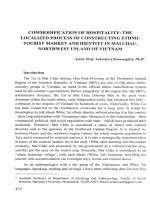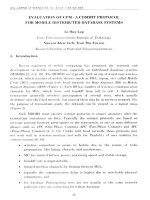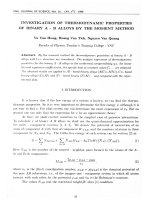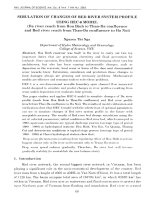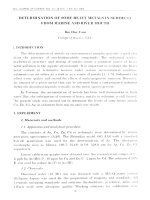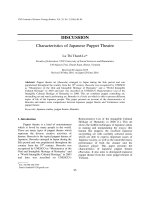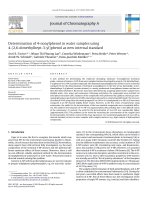DSpace at VNU: Characteristics of polyimide-based composite membranes fabricated by low-temperature plasma polymerization
Bạn đang xem bản rút gọn của tài liệu. Xem và tải ngay bản đầy đủ của tài liệu tại đây (1.07 MB, 7 trang )
Available online at www.sciencedirect.com
Thin Solid Films 516 (2008) 4384 – 4390
www.elsevier.com/locate/tsf
Characteristics of polyimide-based composite membranes fabricated by
low-temperature plasma polymerization
Dung Thi Tran a , Shinsuke Mori b , Masaaki Suzuki b,⁎
a
b
Department of Chemical Technology, Hanoi University of Science, VNU, Vietnam, 334-NguyenTrai, ThanhXuan, HaNoi, Vietnam
Department of Chemical Engineering, Tokyo Institute of Technology, Japan, 2-12-1 O-okayama, Meguro-ku, Tokyo, 152-8552, Japan
Available online 18 October 2007
Abstract
Composite membranes were prepared by the deposition of plasma-polymerized allylamine films onto a porous polyimide substrate. The
relationship between the plasma conditions and the membrane characteristics was described in terms of monomer flow rate, plasma discharge
power, plasma polymerization time, and so on. Scanning electron microscope (SEM) images indicate that the thickness of the plasma polymer
layer increased and the membrane skin pore size decreased gradually with the increasing of plasma polymerization time. Fourier transform
infrared (FTIR) spectra demonstrate the appearance of amine groups in the plasma deposited polymer and the contact angle measurements indicate
that the hydrophilicity of the membrane surfaces increased significantly after plasma polymerization. The composite membranes can reject salt
from sodium chloride feed solution, and membrane separation performance depends strongly on the plasma conditions applied during the
preparation of the plasma deposited polymer films.
© 2007 Elsevier B.V. All rights reserved.
Keywords: Plasma polymerization; Deposition polymer; Composite membrane; Separation performance
1. Introduction
Plasma polymerization is a unique method of modifying
polymers and other material surfaces by depositing a thin
plasma polymer layer onto a substrate surface [1–5]. Plasma
polymer films exhibit many properties different from those of
films fabricated using conventional polymerization methods
due to their special physical and chemical properties, such as a
high degree of cross-linking, pinhole-free uniformity and
extremely strong adherence to the substrate surface [6–10]. In
the field of membranes, plasma polymerization techniques have
been used to prepare highly selective composite membranes,
especially for gas separation, nanofiltration and reverse osmosis processes. Urrutia, Schreiber and Wertheimer [11] have prepared plasma polymer films from monomer mixtures of
hexamethyldisiloxane with methyl methacrylate and styrene
with vinyl acetate, and these plasma polymer films were deposited on porous silicone rubber sheets substrates to form
⁎ Corresponding author.
E-mail address: (M. Suzuki).
0040-6090/$ - see front matter © 2007 Elsevier B.V. All rights reserved.
doi:10.1016/j.tsf.2007.10.069
composite membranes for gas separation processes. Inagaki and
Kawai [12] have used mixtures of perfluoromethylcyclohexane
with methane as the monomer to prepare plasma polymer layers
deposited onto Millipore porous substrates; the formed membranes can be used for the separation of oxygen and nitrogen
mixtures. Nomura et al. [13] have prepared composite membranes
by plasma polymerization using fluoro compound monomers,
with and porous polysulfone hollow fibers as the substrate. Cho
and Ekengren [14] have deposited plasma-polymerized acrylic
acid films onto the surface of various porous support materials
(cellulose acetate, polyethersulfone, polyvinylidene fluoride and
polypropylene) to prepare composite membranes for the ultrafiltration of bleach effluent. Lai and Chao [15] have carried out the
plasma polymerization of hydrophilic monomers such as 1-vinyl2-pyrolidone, 2-hydroxyethyl methacrylate and acrylic acid
to fabricate nylon 4-based composite membranes for desalination.
Tsutsui, Takao and Murase [16] have prepared composite membranes via plasma polymerization using nitrogen-containing
compound as the monomer and porous polyacrylonitrile as the
sublayer. We have modified polyacrylonitrile ultrafiltration
membranes by deposition of a plasma-polymerized acrylic acid
D.T. Tran et al. / Thin Solid Films 516 (2008) 4384–4390
layer onto a substrate membrane surface to form reverse osmosis
composite membranes [17].
Reverse osmosis membranes have a dense skin polymer
layer with no visible pores, in which the separation occurs.
These membranes show different transport rates for permeated
molecules as small as 2–5 Å in diameter. The transport is best
described by the solution–diffusion model. The tiny spaces
between the polymer chains in these membranes are less than
5 Å in diameter and so are within the normal range of thermal
motion of the polymer chains that make up the membrane
matrix [18]. The reverse osmosis process uses the large pressure
difference across the membrane to separate water from salt
solution. The permeated molecules will diffuse through the
dense polymer layer of the membrane and fluctuate in the
polymeric matrix before moving out of the membrane bulk.
Therefore, the membranes have to have a dense enough skin
polymer layer to reject salt and allow water molecules to pass
through. In other words, the separation property of reverse
osmosis membranes is greatly affected not only by the degree of
cross-linking of the membrane skin polymer layer but also by
the hydrophilicity of this polymer.
In this study, reverse osmosis composite membranes were
prepared by radio frequency (RF) plasma polymerization using
allylamine (AlAm) as the monomer and microporous polyimide
(PI) film as the substrate. Microporous PI films are widely used
commercially as separation membranes, and PI is a very useful
material due to its thermal stability (up to 300 °C) as well as its
high chemical resistance. AlAm is an advantageous nonsaturated monomer for plasma polymerization because it requires relatively little energy for polymerization and a large
amount of primary amine groups can be retained in the formed
plasma polymer. The aim of this paper is to describe how
plasma polymerization conditions affect the characteristics of
PI-based composite membranes; also, the influence of plasma
operational parameters on membrane separation performance is
described in terms of the desalination property.
2. Experimental
2.1. Materials
Microporous polyimide films supplied by UBE Co. (Japan)
were used as substrates for the plasma polymerization processes. Scanning electron microscope (SEM) images (Fig. 1)
indicate that virgin porous PI film has an asymmetric structure
with a very high porous sublayer and an average top-layer pore
size of 0.2 μm. Allylamine, purchased from Wako Industrial
Chemicals Co. (Japan), was used as the monomer with no
further purification.
2.2. Preparation of the composite membranes
Composite membranes were prepared by the plasma
polymerization of allylamine vapor to form plasma polymer
films deposited on a porous PI substrate. A 13.65-MHz radio
frequency (RF) plasma generator combined with a matching
unit was used to establish the plasma in the reactor. Details of
4385
Fig. 1. SEM images of virgin porous PI film: (a) cross-section and (b) top surface.
the experimental setup are given elsewhere [17]. The plasma
polymerization system consisted of a tubular reaction chamber
(diameter 30 mm, length 400 mm) with two external electrodes
(8 mm wide and 100 mm apart) connected with a cold trap, a
monomer reservoir with a mass flow meter and connecting
tubes made from glass, a radio frequency power supply with a
matching network; the system also had a pressure gauge and a
vacuum pump.
Porous PI film substrate was placed in the reactor before
evacuating; monomer vapor (allylamine) was introduced into
the reactor at a determined flow rate when the vacuum inside the
reactor reached a pressure below 3 Pa. Then, the RF power
supply was switched on to initiate the glow discharge for plasma
polymerization. In this work, the effects of the monomer flow
rate, polymerization time, power input and deposition pressure on the formed composite membrane characteristics were
investigated.
2.3. Membrane characteristics
2.3.1. Contact angle measurements
The contact angles of water droplets were measured using a
goniometer equipped with a camera which captured images of
drops of room-temperature pure water on the membrane surfaces. For each sample, three drops were placed at different
locations and the average value of these measurements was
calculated.
2.3.2. Fourier transform infrared spectroscopy (FTIR)
Qualitative information of the characteristics of the plasma
polymer was gathered using FTIR spectra. In order to determine
the functionality of the polymer layer deposited on the
membrane surface as a result of due to plasma polymerization,
FTIR spectra were recorded by the attenuated total reflection
(ATR) technique, using a Jeol-SPX 200 spectrometer with a
horizontal ATR device at an incidence angle of 30°. One hundred scans were taken at a resolution of 4 cm− 1.
2.3.3. Scanning electron microscopy (SEM)
The morphological characteristics of the membrane surface
and membrane cross-section were determined by studying
4386
D.T. Tran et al. / Thin Solid Films 516 (2008) 4384–4390
Fig. 2. Influence of the plasma polymerization time on the contact angles to the
membrane surface (plasma discharge of 10 W).
through scanning electron microscope (SEM, Hitachi, S-800)
images. To prevent surface charging, a thin film (5 nm) of Pt
was sputtered onto all samples by means of ion sputter unit
(E-1030, Hitachi) prior to imaging.
2.3.4. Separation performance
The separation performance of the reverse osmosis membranes was determined based on the water flux, J, and the
salt rejection coefficient, R, which are defined by the equations:
J = [V/(S t)] [l/m2 h] and R = {[(C0 − C)/C0] × 100}[%], where V,
S and t are the filtrate volume, the membrane area and the
separation time, respectively; C0 and C are the concentrations
of salt in the feed solution and filtrate, respectively. The
separation performance of reverse osmosis membranes depends strongly not only on membrane characteristics such as the
membrane skin pore size, the degree of cross-linking and the
thickness of the skin polymer layer but also on the relative
transport rates of components, such as their solubility and diffusivity in the membrane.
In this study, the separation performance of a PI-based
composite membrane was evaluated in a desalination experiment using a 3000-ppm sodium chloride (NaCl) feed solution.
Desalination experiments were carried out in Membrane Cell
(Osmonic, USA) under a pressure driving force of 3.5 MPa;
Fig. 3. Influence of the plasma duration and power input on the contact angles to
the membrane surfaces.
Fig. 4. FTIR spectrum of plasma-polymerized allylamine polymer.
the concentrations of salt in the feed solution and filtrate were
determined by conductivity measurements.
3. Results and discussion
3.1. Membrane surface characteristics
3.1.1. Contact angles
Contact angle measurement is one of the simplest methods of
determining the changes in hydrophilicity that take place in the
outermost layer of materials during or after a modification
process. We also used this method to evaluate the changes in the
wettability of the composite membrane surfaces prepared by
plasma polymerization. In this experiment, the plasma processes
were carried out at a fixed monomer flow rate of 2.5 sccm and a
plasma discharge pressure of 18 Pa; the polymerization time and
plasma power input were varied. The correlation between the
contact angles to the membrane surface and the polymerization
time and discharge power is shown in Figs. 2 and 3. The obtained
Fig. 5. FTIR-ATR spectra of virgin PI film and composite membrane surfaces prepared with different plasma polymerization times: (a) virgin PI film,
(b) 10 min and (c) 20 min.
D.T. Tran et al. / Thin Solid Films 516 (2008) 4384–4390
Fig. 6. FTIR-ATR spectra of virgin PI film and PI-based composite membrane
surfaces prepared at different power inputs: (a) virgin PI film, (b) 10 W, (c) 25 W
and (d) 50 W.
results indicate that the membrane surface became more
hydrophilic and that a sharp decrease of the water contact
angles (from 85.1° on virgin PI substrate to 46.5° on plasmapolymerized film) took place during the first 5 min of plasma
polymerization. After that, the contact angles decreased more
slowly with plasma polymerization time at the fixed plasma
discharge power of 10 W (Fig. 2). Apart from that, at the same
monomer flow rate, the contact angles to the membrane surfaces
prepared at 50 W were more acute than those to the surfaces
formed at 10 W and 25 W (Fig. 3). The decrease of the contact
angles could be due to the presence of hydrophilic groups in the
plasma polymer layer deposited on the membrane surface after
plasma polymerization. Since allylamine (CH2 = CH–CH2–
NH2) vapor was used as the monomer, it is plausible to assume
that the hydrophilic groups are primary amine groups.
Furthermore, the amount of these groups in the polymer depends
on the plasma conditions. Qualitative information on the
chemical composition of the membrane surface was given by
the FTIR spectra, as described below.
4387
3.1.2. FTIR spectra
Fig. 4 shows the FTIR spectrum of a plasma-polymerized
allylamine layer deposited onto a CaF2 plate at a power input of
20 W, a monomer flow rate of 2.5 sccm, and a plasma discharge
pressure of 18 Pa for 20 min. The obtained results indicate that
the plasma polymer contains highly dense primary amine
groups. The main peaks are a broad NH2, NH stretching
absorption band between 3500 cm− 1 and 3000 cm− 1, and a
strong NH2, NH vibration absorption band between 1600 cm− 1
and 1500 cm− 1. In addition, there are also some absorption
peaks of the CH2 stretching band between 3000 cm− 1 and
2900 cm− 1, and CH2 and CH vibration bands between 1450 cm− 1
and 1380 cm− 1. Next, the FTIR-ATR spectra of the PI-based
composite membranes surfaces were recorded. Fig. 5 shows the
spectra of virgin porous PI film and PI-based composite
membrane surfaces formed with different plasma polymerization
times (at a fixed power input of 10 W, a monomer flow rate of
2.5 sccm and a plasma discharge pressure of 18 Pa). The results
also demonstrate the appearance of amine groups in the composite
membrane surface as evidenced by the absorption bands between
3500 cm− 1 and 3000 cm− 1, and between 1600 cm− 1 and
1500 cm− 1. Furthermore, the intensity of these absorption peaks
increased with increasing polymerization time. It is well known
that the power input also influences the plasma polymerization
process significantly [19]. Fig. 6 shows the spectra of virgin
porous PI film substrate and PI-based composite membrane
surfaces prepared at different plasma discharge powers. The
obtained results indicate that the intensity of the absorption bands
due to NH2 and NH vibration between 1600 cm− 1 and 1500 cm− 1
in the polymer prepared at 50 W is lower than those in the
polymers formed at 10 W and 25 W. It is reported [20] that plasma
polymerization can take place by either an opening of the monomer double bonds or a formation of reactive species through the
fragmentation of monomer molecules. Opening the double bonds
requires less energy than the dissociation of single bonds or
fragmentation. Therefore, at low discharge powers, plasma
polymerization takes place mainly through the opening of the
double bonds. The energy transferred to the monomer molecules
increases with increasing discharge power, and fragmentation
effects become more important at high discharge powers. Hence,
Fig. 7. SEM images of virgin PI film and PI-based composite membrane surfaces: (a) virgin PI film, (b) 5 min, (c) 10 min and (d) 30 min plasma polymerization.
4388
D.T. Tran et al. / Thin Solid Films 516 (2008) 4384–4390
Fig. 8. SEM images of virgin PI film and PI-based composite membrane cross-sections: (a) virgin PI film, (b) 30 min and (c) 60 min plasma polymerization.
the amount of amine groups in the plasma-polymerized
allylamine film formed at the power input of 50 W may be
smaller than that in the polymers formed at 10 W and 25 W.
3.1.3. SEM studies
The structural characteristics of the membranes were studied by
SEM; images of the top membrane surfaces and the membrane
cross-sections are given in Figs. 7 and 8, respectively. These figures
show morphological images of composite membranes prepared at
a fixed monomer flow rate of 2.5 sccm, a plasma discharge pressure of 18 Pa and a power input of 10 W, with different polymerization times. The pictures show that the membrane skin pore
size decreased gradually during plasma polymerization (Fig. 7).
Also, the thickness of the deposited plasma polymer layer
increased with increasing plasma duration (Fig. 8). The results
indicate that the deposition of plasma polymer takes place not only
in the surface but also in the skin pores of the substrate membrane.
and a plasma discharge pressure of 18 Pa. The influence of the
polymerization time on the separation property of the composite
membranes is illustrated in Fig. 9. The experimental results
indicate that membrane salt rejection (R) increased and water
flux (J) decreased quickly within the first 20 min of polymerization. This altering of the membrane separation property
could be the result of changes in membrane morphology which
occurred during plasma polymerization, in which the membrane
skin pore size decreased and the thickness of the top layer
increased due to the deposition of the plasma polymer layer
onto the substrate membrane surface.
3.2.1. Influence of the plasma polymerization time
In this experiment, plasma polymerization was carried out at
a fixed power input of 10 W, a monomer flow rate of 1.5 sccm
3.2.2. Influence of the monomer flow rate
In this experiment, the monomer flow rate range was varied
from 1.5 to 6.0 sccm, the plasma discharge power was maintained at 10 W, the polymerization time was fixed at 20 min and
the plasma discharge pressure was 20 Pa. The experimental
result (Fig. 10) shows that there is an optimum range of monomer flow rate (from 2.0 to 3.0 sccm) in which the obtained
membranes have a higher selectivity. At insufficiently high
monomer flow rates (below 1.5 sccm), it is plausible to assume
that the separation property of the membranes is poor because of
the extremely low salt rejection coefficient, R. However, when
Fig. 9. Influence of the plasma duration on the separation performance of PIbased composite membranes.
Fig. 10. Influence of the monomer flow rate on the separation performance of PIbased composite membranes.
3.2. Membrane separation performance
D.T. Tran et al. / Thin Solid Films 516 (2008) 4384–4390
the monomer flow rate exceeds the optimum range (higher than
4.0 sccm), the selectivity of the membranes worsens again. The
changes in the selectivity of the membranes relate to the
changes in the characteristics of the plasma polymer layer
formed at different monomer flow rates. The following presumptions are considered: at insufficiently high monomer flow
rates, the deposition rate of the polymer is very slow, and after
20 min of polymerization the formed deposition layer is not
thick enough to create a selective barrier layer which can reject
the salt from the feed solution. In the optimum monomer flow
rate range, the deposited polymer film can work as an active
barrier layer to reject the salt. At excessive monomer flow rates,
deposited polymers with lower cross-linking are formed
because the resident time of the monomer in the reactor
decreases and the plasma energy transferred to the monomer is
reduced when the monomer flow rate increases, thereby
reducing the salt rejection capability of the barrier layer. This
effect should be investigated in more detail in future studies.
3.2.3. Influence of the plasma discharge power
Plasma polymerization was carried out at a fixed monomer
flow rate of 2.5 sccm, a plasma discharge pressure of 18 Pa and
a polymerization time of 20 min; the power input range was
varied from 10 W to 40 W. Fig. 11 shows the influence of the
plasma power input on the separation property of the composite
membranes. The results indicate that the membrane salt
rejection increased and the water flux decreased with increasing
plasma power. Because the fragmentation effect of the
monomer molecules becomes more dominant when the plasma
power increases [19], a plasma polymer with higher crosslinking would be formed at high discharge powers, whereas a
little branched polymer would be formed at low discharge
powers; this may be why membranes prepared at low discharge
powers have smaller selectivity.
3.2.4. Influence of the deposition pressure
In this experiment, plasma polymerization was carried out
under the fixed conditions with a monomer flow rate of
2.5 sccm, a power input of 10 W and a polymerization time of
20 min. The influence of the deposition pressure on the membrane separation property is shown in Fig. 12. It is well known
4389
Fig. 12. Influence of the plasma discharge pressure on the separation performance
of PI-based composite membranes.
that the deposition rate of a plasma polymer in a flow system is a
function of the working gas pressure, and that the working gas
pressure strongly influences the plasma polymer's characteristics [1]. In this experiment, the working gas pressure was
varied from 10 Pa to 30 Pa, and the results obtained from the
separation experiment show that the salt rejection decreased and
the water flux increased as the when working gas pressure
increased. We consider that increasing the working gas pressure
can induce the increase of the deposition rate of the plasma
polymer, the reduction of the cross-linking degree of the deposited polymer and consequently the reduction of the selectivity of the composite membrane.
4. Conclusion
The preparation of reverse osmosis composite membranes
using plasma polymerization was carried out by deposition of
plasma-polymerized allylamine films onto a porous polyimide
sublayer. The influences of the preparation conditions on the
membrane properties was determined by investigating the membrane surface characteristics and the membrane separation performance. The results of this work indicate that the thickness of
the plasma deposited films increases and the membrane skin
pore size decreases gradually with polymerization time. Membrane surfaces become more hydrophilic due to the appearance
of amine groups in the plasma deposited polymer layers. The
characteristics of plasma deposited polymer films and the
separation performance of PI-based reverse osmosis composite
membranes depend strongly on the plasma polymerization conditions, such as the monomer flow rate, the plasma discharge
power and the deposition pressure. The experimental results
suggest the existence of an optimum monomer flow rate range
and a critical discharge power, as well as a proper deposition
pressure region in which the formed composite membranes have
a high selectivity and a good water flux.
Acknowledgments
Fig. 11. Influence of the power input on the separation performance of PI-based
composite membranes.
The authors would like to thank the UBE Company (Japan)
for their cooperation and for kindly supplying us with the
microporous PI substrate membranes.
4390
D.T. Tran et al. / Thin Solid Films 516 (2008) 4384–4390
References
[1] H. Yasuda, Plasma Polymerization, Academic Press, Orlando, 1985.
[2] H. Biederman, Y. Osada, Plasma Polymerization Processes, Elsevier
Science Publishing Inc., New York, 1992.
[3] C.M. Chan, T.M. Ko, H. Hiraoka, Surf. Sci. Rep. 24 (1996) 1.
[4] H. Aizawa, et al., Mater. Sci. Eng., C, Biomim. Mater., Sens. Syst. 12
(2000) 49.
[5] V. Sciarratta, U. Vohrer, D. Hegemann, M. Muller, C. Oehr, Surf. Coat.
Technol. 174-175 (2003) 805.
[6] N. Suzuki, Y. Ogushi, K. Imai, N. Ohta, S. Ueno, U.S. Patent No. 4639285
(1987).
[7] S. Ueno, H. Nomura, K. Imada, U.S. Patent No. 4429024 (1984).
[8] J.D. Masso, W.D. Brennan, D.H. Rotenberg, U.S. Patent No. 4478873
(1984).
[9] S. Ueno, H. Nomura, K. Imada, U.S. Patent No. 4548867 (1985).
[10] T. Akagi, I. Sakamoto, S. Yamaguchi, U.S. Patent No. 4728564 (1988).
[11] M.S. Urrutia, H.P. Schreiber, M.R. Wertheimer, J. Appl. Polym. Sci., Appl.
Polym. Symp. 42 (1988).
[12] N. Inagaki, H. Kawai, J. Polym. Sci., Part A, Polym. Chem. 24 (1986)
3381.
[13] H. Nomura, P.W. Kramer, H. Yasuda, Thin Solid Films 118 (1984) 187.
[14] D.L. Cho, O. Ekengren, J. Appl. Polym. Sci. 47 (1993) 2125.
[15] J.Y. Lai, Y.C. Chao, J. Appl. Polym. Sci. 39 (1990) 2293.
[16] N. Tsutsui, S. Takao, I. Murase, U.S. Patent No. 4283359 (1981).
[17] T.D. Tran, S. Mori, M. Suzuki, Thin Solid Films 515 (2007) 4148.
[18] R.W. Baker, Membrane Technology and Applications, John Wiley & Sons
Ltd, 2004.
[19] H.K. Yasuda, Plasma Process. Polym. 2 (2005) 293.
[20] D.L. Cho, M. Claesson, C. Golander, K. Johansson, J. Appl. Polym. Sci.
41 (1990) 1373.

